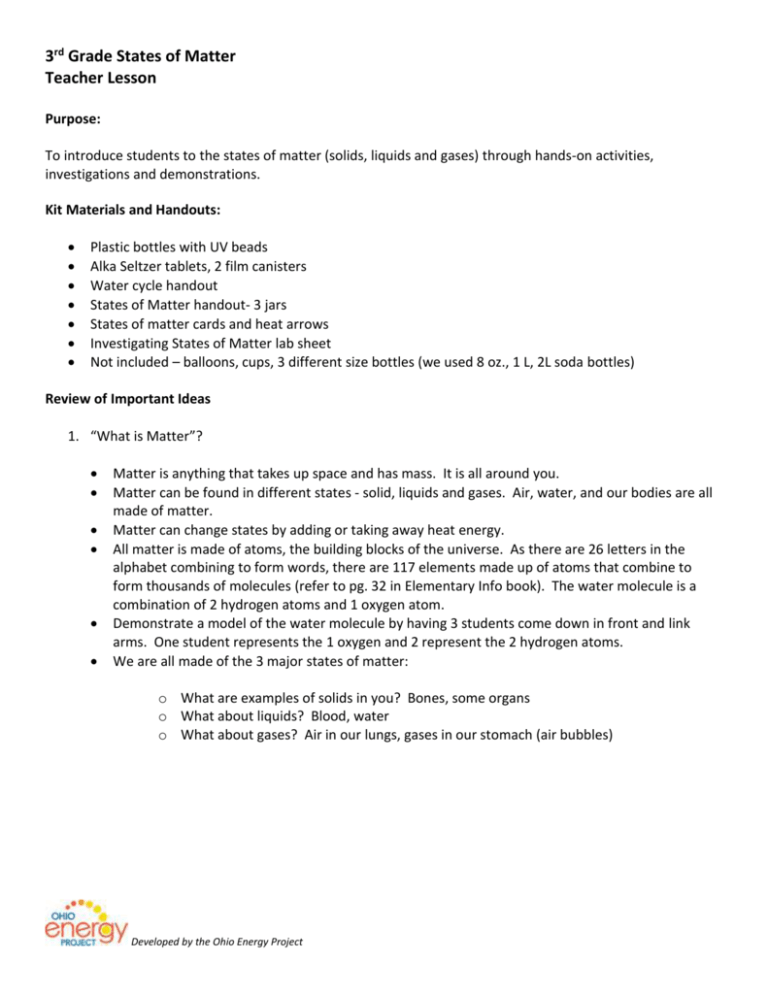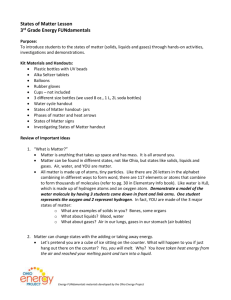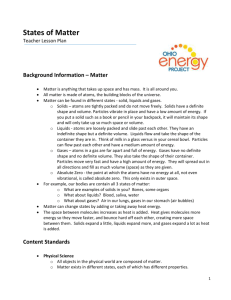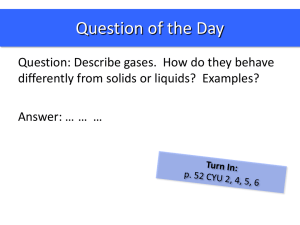States of Matter Teacher Lesson
advertisement

3rd Grade States of Matter Teacher Lesson Purpose: To introduce students to the states of matter (solids, liquids and gases) through hands-on activities, investigations and demonstrations. Kit Materials and Handouts: Plastic bottles with UV beads Alka Seltzer tablets, 2 film canisters Water cycle handout States of Matter handout- 3 jars States of matter cards and heat arrows Investigating States of Matter lab sheet Not included – balloons, cups, 3 different size bottles (we used 8 oz., 1 L, 2L soda bottles) Review of Important Ideas 1. “What is Matter”? Matter is anything that takes up space and has mass. It is all around you. Matter can be found in different states - solid, liquids and gases. Air, water, and our bodies are all made of matter. Matter can change states by adding or taking away heat energy. All matter is made of atoms, the building blocks of the universe. As there are 26 letters in the alphabet combining to form words, there are 117 elements made up of atoms that combine to form thousands of molecules (refer to pg. 32 in Elementary Info book). The water molecule is a combination of 2 hydrogen atoms and 1 oxygen atom. Demonstrate a model of the water molecule by having 3 students come down in front and link arms. One student represents the 1 oxygen and 2 represent the 2 hydrogen atoms. We are all made of the 3 major states of matter: o What are examples of solids in you? Bones, some organs o What about liquids? Blood, water o What about gases? Air in our lungs, gases in our stomach (air bubbles) Developed by the Ohio Energy Project Investigations and Demos – Summarize information from activities 1 – 4 on the States of Matter Labsheet 1. Bottles & Beads Let’s review the four states of matter with bottles and beads representing atoms: Absolute Zero - the point at which the atoms have no energy at all, not even vibrational, is called absolute zero. This only exists in outer space. Have the student’s model with their bottle how the atoms move at absolute zero. Solids – atoms are tightly packed and do not move freely. Solids have a definite shape and volume. If you put a solid such as a book or pencil in your backpack, it will maintain it’s shape and will only take up so much space or volume. Have the student’s model with their bottle how the atoms move in a solid. o Look around the classroom and think of home. What are some examples of solids? We can change the shape of a solid, but we have to use energy to do it. For example, we can crush a rock. We can change the shape of a piece of paper by crumbling it. Liquids - atoms are loosely packed and slide past each other. Liquids flow and take the shape of the container they are in. They have an indefinite shape but a definite volume. For example, if you took a hose and filled a bucket versus a pool, the water would change shape depending on the container. Think of milk in a glass versus in your cereal bowl. Have the student’s model with their bottle how the atoms move in a liquid. o Look around the classroom and think of home. What are some examples of liquids? Using three different size plastic bottles, you can measure an exact amount of liquid (colored water works great) and pour that same amount in an 8 oz. bottle, 1 L and a 2 L bottle. They can see that liquids look different in each container, reinforcing that liquids take the shape of their container, but have a definite volume, which was measured. o Optional – water molecules like to stick together. Water has a quality called surface tension, which results from the great attraction of water molecules to each other. To illustrate this concept, you can fill a glass of water until it almost overflows, and then carefully place a straight pin on top of the water and it should float. Gases – atoms in a gas are far apart and full of energy. Gases have no definite shape and no definite volume. They also take the shape of their container. They will spread out in all directions and fill as much volume (space) as they are given. Have the student’s model with their bottle how the atoms move in a gas. o Look around the classroom and think of home. Using different sized balloons, show the students with an equal amount of blowing in each of the balloons, that gases have no definite shape or volume and will fill as much space as possible. Developed by the Ohio Energy Project 2. “Acting Out” the States of Matter Hold up the states of matter cards plus the absolute zero card and have students use the bottles to demonstrate the motion of the particles. Get them really going by showing the words quickly so they have to act fast. Students can also use your bodies to act out the three states of matter by vibrating and standing close together to show a solid, then arms length apart with their arms moving to show a liquid, and then walking fast around the room to show a gas. 3. Life Cycle of an Ice Cube/States of Matter Cards Optional: If you have a heat source in your classroom, you can put the ice cube on a hot plate and show all three states of matter. Water can change states by adding or taking away heat energy. Using the states of matter cards, have students use the word arrows (MELTING, EVAPORATION/BOILING, CONDENSATION AND FREEZING) to show how energy is transferred to change states of matter. o Melting – if an ice cube is left on the counter, the ice will take heat ENERGY IN (show with red arrow on solid ice to liquid) from the air and will MELT to form water. o Evaporation/Boiling- If the water is left on the counter, it will take ENERGY IN from the air and EVAPORATE. If the cube is put on a hotplate, the water will take ENERGY IN (show with red arrow on liquid to gas) and will BOIL and turn into a gas or steam. o Condensation - if we take ENERGY OUT (show with red arrow on gas to liquid) of a GAS, it will become a liquid again or CONDENSE. o Freezing – if we take ENERGY OUT (show with red arrow on liquid to solid) of a liquid to go back to an ice cube, the liquid will have to go into the freezer to remove even more heat energy. The water will reach the freezing point and become an ice cube. 4. Investigations of Solids, Liquids and Gases Demo – measure a cup of vinegar into a 2 liter bottle. Add 2 tablespoons of baking soda (you can put it directly into the balloon) and quickly put a balloon over the bottle and watch the balloon enlarge showing the gas formation in the bottle and balloon. A solid (baking soda) was added to a liquid (vinegar) and produced a gas (carbon dioxide). Demo – take a can of pop (can is solid), pop inside (liquid), and pull the tab to show the formation of a gas (carbon dioxide). In small groups – the “Mystery Tablet” o Divide the students into groups and give them a cup and 1/2 of an Alka Seltzer tablet. Have them fill the cup about a ¼ full with water. Developed by the Ohio Energy Project o Have them record on their “Investigating States of Matter” lab sheet what they predict will happen when you drop the mystery tablet into the water. o At one time, ask all the groups to drop the tablet into the water. Ask them to put their hand over the cup so they can feel the gas. What is this process similar to? Like the bubbles of a pop when you open it! o Optional: to show what can happen when a gas is contained, you can take one or several film canisters and add about 2/3 water (liquid) and ¼ of an alka seltzer tablet (solid). Close the lid and wait. The canister will pop due to the formation of gas. Safety note: the lid on the canister really moves, so make sure the kids are far away from the canister. The reaction happens very quickly. Optional activities: o Making jello is a great way to reinforce the three states of matter. It starts with a solid (the powder), add water (liquid) and through boiling, a gas is produced. After putting it in the refrigerator (taking energy out), the jello has turned back into a solid. o Make a Venn diagram, showing the relationship between states of matter. Visit the OEP website to print a Venn diagram handout. o “Who Has It?” – interactive card game that reinforces the states of matter and the terms in the lesson. For example, one student would have a card that says – Who has something that says, this is a gas to a liquid? Another student would have the word condensation. This game will also be on the OEP website. o “What’s-the-Matter?”Party and make root beer floats. Start with ice cream (solid), add root beer (liquid), and you get the carbonation in the root beer (carbon dioxide gas). 5. Water Cycle – see handout How do all these energy transfers happen in nature? Through the water cycle, which is the natural sequence through which water passes into the atmosphere as water vapor, comes down as precipitation in liquid or solid form, and ultimately returns to the atmosphere through evaporation. Distribute the handout on the water cycle. Have students describe on the “Investigating States of Matter” handout (using the words from investigation No. 3) how the water cycle works in nature. Developed by the Ohio Energy Project










